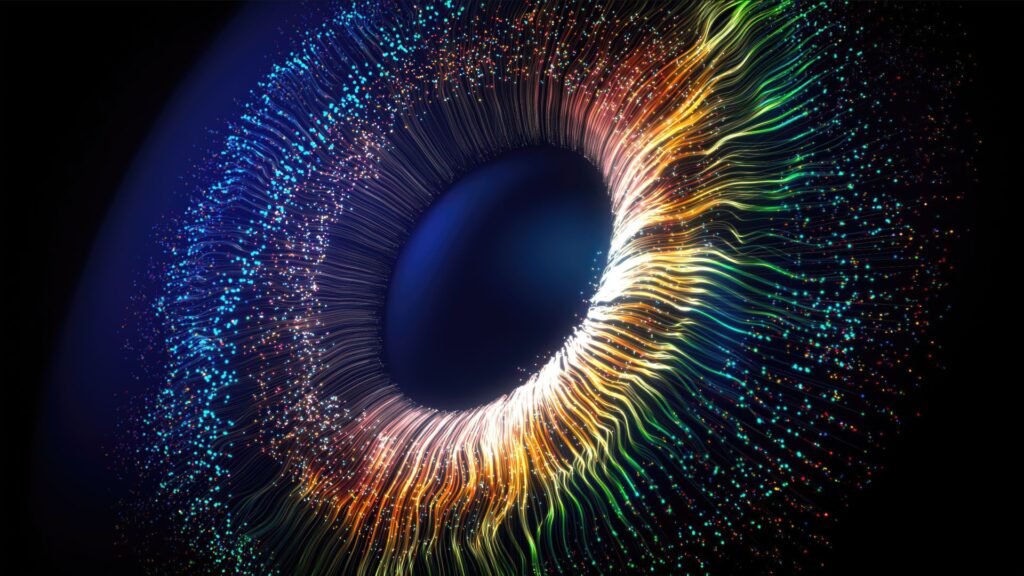
Scientists Discover “Olo” – A New Color the Human Eye Has Never Seen Before
Colors have always fascinated humanity. From the vibrant blues of the ocean to the deep greens of forests, our ability to perceive thousands of color variations shapes the way we experience the world. Now, a team of researchers from the University of California, Berkeley, and the University of Washington has made a groundbreaking discovery — a new color called “Olo” that has never been seen by human eyes before.
How Was the New Color Discovered?
The color Olo was made visible using a pioneering technique known as “Oz.” This method uses advanced laser technology to directly stimulate specific photoreceptors (light-sensitive cells) in the human eye.
Researchers specifically targeted the M-cones, which are responsible for detecting green wavelengths of light.
Using the Oz technique, laser pulses were carefully directed at individual photoreceptors, allowing five participants in the experiment to perceive a color beyond the traditional range of human vision. This was a color that doesn’t exist naturally within the human visual spectrum — until now.
What Does Olo Look Like?
Olo has been described as a highly saturated blue-green, somewhat resembling teal, but with a level of richness and intensity never experienced before.
However, Olo cannot be replicated on any current digital display, VR headset, or printed surface. No screen technology today is capable of rendering the exact experience of Olo because it exists outside the traditional RGB color model.
Simply put, Olo is not just another shade — it is a fundamentally new visual experience.
Is Olo Truly a “New” Color?
Technically, the wavelengths involved have always been present in the universe. However, due to the limitations of human vision, we have been unable to perceive certain combinations and intensities. Olo was hidden from us, waiting for the right technology to reveal it.
Thus, Olo represents not a newly created color, but a newly accessible one. It’s an expansion of the known boundaries of human sight.
The Limits of Human Vision
Typically, human vision is based on three types of cones in the retina — sensitive to red, green, and blue light. Our perception of the millions of colors we see is based on how these cones respond in combination.
Olo’s discovery suggests that there may be many other visual experiences possible if we can find ways to stimulate the photoreceptors differently.
In other words, our natural perception might just be the tip of the iceberg.
Applications and Future Potential
Currently, the Oz technology is primarily used in medical research, particularly for studying eye diseases.
However, the researchers are optimistic about broader applications. One promising area is the treatment of color blindness.
If specific photoreceptors can be artificially stimulated, it may become possible to help colorblind individuals experience a full spectrum of colors they currently cannot see.
Imagine a future where a person with red-green color blindness can, for the first time, perceive the richness of a sunset — all thanks to technologies like Oz.
Challenges to Wider Use
Despite its exciting potential, several hurdles remain:
- Safety Concerns: Using laser pulses directly on the retina must be handled with extreme care to avoid damage.
- Technical Complexity: The current systems are bulky, expensive, and require highly trained operators.
- Miniaturization: Bringing this technology into everyday life (e.g., compact glasses or consumer devices) is still a distant goal.
Before the general public can experience Olo, scientists must overcome these substantial technical and biological barriers.
Philosophical and Psychological Questions
The discovery of Olo isn’t just a scientific breakthrough — it raises profound philosophical and psychological questions:
- How will the human brain categorize a color it has never seen before?
- Could the ability to perceive more colors alter our emotional and cognitive responses?
- Might we develop new vocabulary, art styles, or even new forms of communication around newly discovered colors?
Researchers are already exploring these ideas, suggesting that the discovery of new sensory experiences could fundamentally reshape human consciousness over time.
Hope for Color Blindness Treatment
One of the most exciting implications of this research is the potential impact on individuals with color blindness.
If scientists can use laser technology to selectively stimulate missing or non-functional cones, they could “restore” normal color vision — something previously thought impossible without genetic intervention.
This approach would offer a non-invasive, adjustable way to “correct” color blindness, potentially improving the quality of life for millions worldwide.
Reaction from the Scientific Community
The unveiling of Olo has sparked major excitement within the scientific community. Many researchers view it as a historic milestone in our understanding of human perception.
Some vision scientists have even speculated that in the future, we might expand human vision beyond the current “visible light spectrum” altogether, enabling us to perceive ultraviolet or infrared colors naturally — just as bees or snakes do today.
While these ideas remain theoretical for now, Olo is a tangible first step toward expanding human sensory capacity.
Could We One Day See More Colors?
If technologies like Oz continue to advance, it’s not far-fetched to imagine a future where humans can regularly experience colors that today we can barely even describe.
Artists, designers, and technologists could one day work with entire palettes of “super colors” — hues that are currently invisible and unnamed.
Such an expansion of perception would revolutionize industries ranging from art to virtual reality, and from education to healthcare.
Summary
The discovery of Olo reminds us that human potential is greater than we often realize. Even something as seemingly basic as sight still holds mysteries waiting to be unlocked.
With technologies like Oz, we may be on the verge of redefining what it means to “see.”
Perhaps the world we know is only a fraction of what is truly there — and with each scientific breakthrough, we step closer to experiencing the full spectrum of reality.